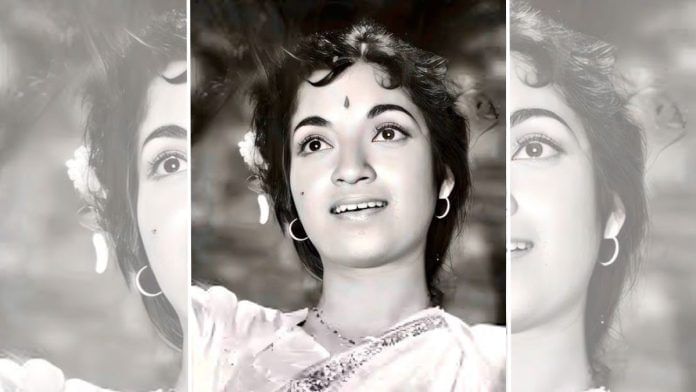New Delhi: Sandhya Shantaram’s life is a masterclass in transformation. Born on 13 September 193, in Andhra Pradesh and raised with no formal background in theatre or classical dance, Vijaya Deshmukh’s path was anything but destined. Yet, it was her voice—uncannily similar to actor Jayshree’s—that caught the attention of filmmaker V Shantaram. He cast her in the 1951 film Amar Bhoopali and gave her a new name: Sandhya. She went from an untrained newcomer to the unshakable centre of some of Indian cinema’s most iconic films.
Her role in Amar Bhoopali, a singer who becomes the muse of the legendary Marathi poet Honaji Bala, demanded months of intense classical dance training. With no prior experience, Sandhya threw herself into the art with almost ascetic discipline.
By 1956, just before the Hindu Marriage Act outlawed polygamy, she married Shantaram—37 years her senior—and became the emotional and artistic heart of his creative household. Though they never had children together, Sandhya helped raise his from two previous marriages.
She passed away peacefully on 4 October at the age of 87. The legendary actor didn’t just adapt to cinema—she reshaped it in her image.
‘Poetry in motion’
Her artistry—especially in dance–was neither showy nor ornamental. In Jhanak Jhanak Payal Baaje (1955), she played Anjana, a Kathak dancer whose art is tested by love. Though she had no classical training before films, Sandhya immersed herself so deeply that her duet ‘Nain So Nain’ with Gopi Krishna became a cinematic benchmark.
She brought similar depth to Do Aankhen Barah Haath (1957), playing Champa, a toy seller whose gentle presence reforms a group of hardened prisoners.
“Whether it was the tender moments, when prisoners turned their hardened gaze to her as the toy seller, or the spirited glow she radiated in the playful ‘Saiyan Jhooton Ka Bada Sartaaz Nikla’, her performances transcended mere acting to become poetry in motion,” said filmmaker and photographer Rajeev Srivastava.
Her most defining role was perhaps in Navrang (1959). As both Jamuna, the neglected wife, and Mohini, her husband’s fantastical muse, Sandhya danced the myth and reality of womanhood in a dual role that demanded total surrender. In the Holi song ‘Are Ja Re Hat Natkhat’, she danced with a live elephant, shifting seamlessly between male and female personas while balancing matkas atop her head—an unparalleled moment of cinema, choreographed by Sandhya herself.
Her input didn’t stop at performance. In Jal Bin Machhli Nritya Bin Bijli (1971), she dictated the choreography for ‘Kajra Lagake Re’, influencing even the music composition—a rare moment where dance shaped melody, not the other way around.
Her reach extended into Marathi cinema too. In Pinjra (1972), she played Chandrakala, a tamasha artist who falls in love with the village teacher. Her performance in the song, ‘Tumhavar Keli Mi Marji Bahal’, combined the personas of calculating temptress and yearning heroine. The role earned her a Filmfare Marathi nomination and sealed her place as a cultural bridge between folk and classical, rural and urbane.
“Her classical dance sequences remain etched in cinematic history, showcasing a dancer whose control was matched only by her delicate expressiveness,” said Srivastava.
Also read: Remembering V Shantaram, an innovator and pioneer of women-oriented films
Beyond the spotlight
Despite the grace she brought to every frame, Sandhya never pursued stardom for its own sake. She didn’t give interviews often. She didn’t market herself. She chose instead to disappear into her characters—and later, into a quiet retirement in Mumbai.
“Despite being instrumental to some of Indian cinema’s most enduring moments, Sandhya’s luminous legacy often lies in the shadows of greater accolades, perhaps because her subtlety was not always heralded in an industry enamoured with grandeur,” said Srivastava.
But those who worked with her knew better. She was not just V Shantaram’s wife—she was his artistic equal. Whether helping choreograph, developing characters, or mentoring young talent, Sandhya’s fingerprint was on every part of their cinematic tapestry.
“Sandhya elevated V Shantaram’s films from mere stories to timeless celebrations of music, dance, and human emotion,” Srivastava said.
In Stree (1961), Sandhya acted alongside real lions for the forest scenes, unflinching in her commitment. She introduced her niece, Ranjana Deshmukh, into cinema—extending her legacy without ever claiming the credit.
Her final public appearance at the 2009 V Shantaram Awards, marking 50 years of Navrang, was all about honouring her indelible mark on cinematic aesthetics.
“To revisit Sandhya’s work is to rediscover a rare beauty and quiet strength that still calls out across the decades to all who cherish classic Indian cinema,” Srivastava said.
(Edited by Prasanna Bachchhav)






